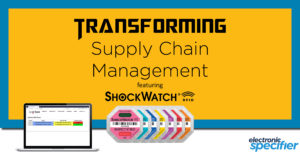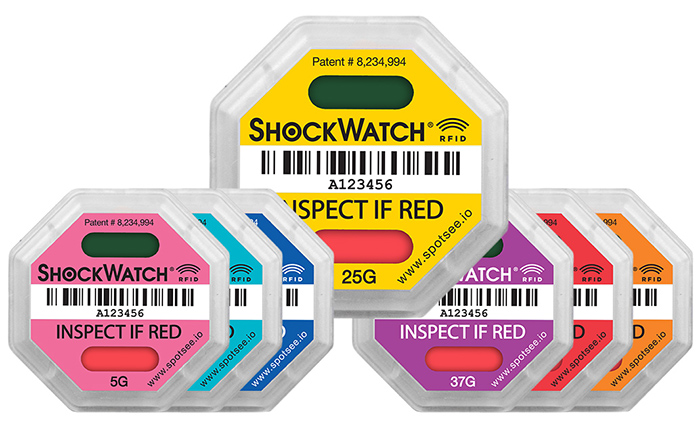SpotSee Featured on Electronic Specifier: Transforming Supply Chain Management
 In any given supply chain, there’s at least one step that requires items or products to be transported from one place to another, even if that step takes place between the supplier and the end user. Jan van Niekerk of SpotSee explains.
In any given supply chain, there’s at least one step that requires items or products to be transported from one place to another, even if that step takes place between the supplier and the end user. Jan van Niekerk of SpotSee explains.
In more complex supply chains there are multiple checkpoints that products are required to go through to be created, assembled, moved from location to location, sometimes from country to country, and eventually delivered to the end user. By the time a person or business receives a shipment, it has likely passed through several hands.
Each step serves a purpose, whether it’s furthering the product’s creation or simply transporting it closer to the delivery location. As such, the goal of each handler is to complete their given task. Unfortunately, that sometimes means packages get lost and/or damaged.
Since its initial development in the 20th century for electronic tolling, passive radio devices have become a viable method for identification and tracking. Designed to work within almost any industry, radio-frequency identification (RFID) tags simplify complex supply chains by automating the sorting process. Though RFID has undoubtedly improved the inventory tracking process in the supply chain, many organisations aren’t yet capitalising on the management capabilities it can provide when combined with condition tracking.
What is RFID?
How exactly does RFID work? RFID tags consist mainly of three parts – an antenna, a receiver/transmitter and memory. These devices completely eliminate the need for a battery by utilising the energy from the reader’s signals to power the device. The elimination of a battery reduces cost and size, eliminates sensitivity to environmental temperatures and shelf life, and lithium battery safety issues. By allowing a reader to read the contents of the on-board memory, RFID tags work similar to barcodes that you see on products at the supermarket. Barcodes contain data about the item in a visual, machine readable form. Both are methods of automatic identification and data capture in which items are identified, data is collected and then entered into a computer system. At the time of purchase, a barcode is scanned and the price appears, typically with a description of the item. You pay for your products and the tag is disposed.

Similarly, RFID consists of a reader, a reader antenna and a tag. RFID tags are scanned and the collected data is sent back to the reader, a process equivalent to scanning a barcode and seeing the item code on the screen. The electromagnetic energy from an RFID reader device triggers the tag, commanding it to transmit data back to the reader. What used to require manual intervention can now be accomplished by simply implementing an RFID reader. Unlike barcoding, RFID tags don’t require line-of-sight visibility, meaning they can be attached to or embedded in products. They can be manifested as tags on clothing to prevent shop lifting, fobs for accessing buildings and other types of devices.
RFID in the supply chain
RFID is especially useful in the supply chain industry, as it helps companies and warehouses automatically track inventory from start to finish, helping users understand where items are and where they’ve been. When integrated with an enterprise resource planning (ERP) or warehouse management system (WMS), handlers receive information in real-time. This permanent record, updated as a shipment and makes its way from place to place, can help keep track of containers without the need for human intervention. Trying to locate and log each individual pallet by hand is resource intensive, requiring a lot of costly manual labour. On top of the time it would take to do everything by hand, there’s also an increased risk of human error. RFID’s accurate, quick and automatic logging process significantly reduces the time needed to account for inventory, creating a more efficient supply chain and eliminating excess costs.
However, while useful for identifying and logging an editable record of an item’s whereabouts, RFID tags alone don’t account for an item’s condition. When combined with other technology, like condition-monitoring devices, including temperature and impact monitoring equipment, it becomes a diagnostic device as well as a damage deterrent.
Impact monitoring devices
One of the most prevalent issues in the supply chain industry is damage. Every year, trillions of dollars’ worth of shipped goods are damaged. Damage doesn’t discriminate based on industry. It can occur in every instance, whether the products being shipped are medical devices, electronics, appliances, furniture or other materials.
Major damage is often noticeable, causing cracks, rips or misshapen boxes. But some damage, without proper inspection, can go unnoticed from place to place, getting worse in the process. Sometimes, damage can take months to manifest, causing even more problems that trigger the need for warranty repairs when really, the damage isn’t even the manufacturer’s fault. This incorrectly burdens the manufacturer with fixing or replacing the item, costing them time and other resources. If issues go unnoticed continuously, it can cause irreparable damage to the manufacturer’s bottom line and brand reputation.
To better understand where damage is occurring within the supply chain, many companies implement impact monitoring devices. Impact monitoring devices introduce end-to-end accountability and oversight into the supply chain.
These devices typically work by registering potentially damaging impacts and alerting handlers to potential damage with visual cues, like a colour changing indicator. This communicates to the next person in the chain that the shipment should be assessed for damage and allows them to quickly decide on a plan of action. Impact monitors and indicators are similar to RFID readers in that they also identify and track – except that the data they provide is damage-specific and doesn’t necessarily integrate into a management system.
Impact monitoring
Combining RFID tracking with impact monitoring creates a comprehensive system for detecting and diagnosing damage in the supply chain. Leveraging all the features that both have to offer, this kind of device redefines inventory management. Instead of simply identifying inventory as it passes through a supply chain checkpoint, impact monitoring equipped RFID tags automatically spot and differentiate which items require damage inspection and which are good to go.
While visual cues from impact monitoring indicators alert a handler of damage after receiving a shipment, handlers are still required to report the damage, putting them in control of the data. Human error means it could be reported incorrectly, or not at all, making it hard to spot potential trends and assign appropriate responsibility. RFID readers log a permanent, unalterable record every time they read a tag. This provides users a clear view of when and where a package was damaged, and by who. By linking this data directly into an ERP or WMS, visual cues become less important. Thousands of tags can be read for tracking purposes and evaluated for g-force threshold deviations within seconds, eliminating the need for human intervention and allowing labour cost to be reduced.

These types of devices, like SpotSee’s ShockWatch RFID indicator, are cost-effective and easy to use. Passive RFID technology allows the device to be energised by energy from the RFID reader, meaning battery life is never an issue. Both field armable and tamper resistant, they can be deployed anywhere, at any time, and without fear that they could be easily removed or manipulated. Although visual cues are no longer needed to identify damage, the physical indicator still acts as a deterrent, communicating to handlers throughout the process that there is a monitoring programme in place.
This kind of combination device provides all the benefits of an impact monitoring and inventory management programme. When left unaddressed, supply chain discrepancies can have long-term effects on a company. When items are continuously mishandled, they might require repair or replacement, which means expending resources and potentially incurring additional costs. This could be payment for employees, the cost of replacing an item or the profit that’s lost as a result of a disruption in the usual supply chain process.
A supply chain is only as strong as its weakest link, which reinforces the need for real-time end-to-end visibility, quick decision making and resilience. For years, RFID tags and readers have played a critical role in managing supply chains and improving inventory control. When combined with a condition-management solution, they mitigate damage and loss, simplify complex processes, reduce costs and create a more efficient supply chain.
Contact us with the form below to schedule a consultation about SpotSee’s passive RFID solutions.







